


| 17 of Academy Aikido Jyuku members' made a trip to Chichibu, Saitama prefecture after gratification of the 9th International Aikido Federation Seminar at Yoyogi in Tokyo that was described vividly in this article. This is a trip to see the genuine Katana or Tachi (the soul of Bushi) which flew everyone back to the olden times. The trip might help deepen some sort of Aikido basic knowledge. |
|
|
| Academy Aikido Jyuku would like to thank them for their contribution and hope the browsers will share the fantasy of these authors. This nice-to-know story written by Sheikh Fuad bin Sheikh Mahmud and Fareen Shazli B. Ali, Aikido enthusiasts. |
|
|


|
My first experience of Japan and the Japanese people were probably from James Clavell's classic, "SHOGUN". It left quite an impression. The pure values, the way of the Samurai, of honour and nobility that were portrayed in "SHOGUN" must have influenced my current perceptions. My journey in Aikido must have also started then. Almost thirty years after reading "Shogun" I made my first physical trip to Japan to attend the 9th International Aikido Federation (IAF) seminar at the Yoyogi Youth Complex in Tokyo. That one week was one childhood fantasy fulfilled. Tokyo is super modern, surprisingly clean and orderly considering it's the busiest city on earth. But amidst all that hi-tech environment I sensed those ancient values that I have always imagined to be 'Japanese', are still deeply rooted in modern day Japanese people. I feel that the samurai values are very much alive in their culture in the sense that they were disciplined, respectful and humble. A friend who also came for the IAF seminar commented that he didn't see any police around and I agreed. Later a Malaysian I met there, told me that the crime rate is so low in Tokyo that to meet a Police you'll have to visit the Police Station! |
 |
 |
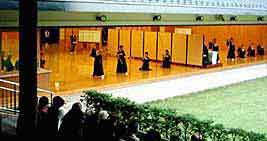 |
I was particularly amazed to see the elderly still physically active, practicing physical arts like Aikido and Kyudo and riding on bicycles up and down hilly paths. To see people wearing suits to work and riding bicycles is a common sight. |
|
While in Tokyo, we were invited to take a trip to Shihan Jun Yamada's family home in Chicibu. That was the highlight of my seven day trip. Chicibu was about 1 1/2 hours by a few change of trains from where we were staying. It was a pleasant scenic ride into the country, a marked contrast from the hustle and bustle of Tokyo. At one of the country stops, we had enough time to enjoy a bowl of local noodles before the next train. That was really tasty (...can still taste it on my lips..no kidding!). When we arrived at the final train stop at Kami-Nagatoro, we had to make a 20 minute walk to our destination. I later learned that before the war, Shihan Yamada's family used to own land stretching from that train stop right up to the family's home and beyond. |
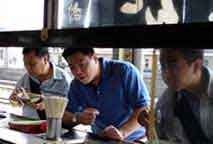 |
| We walked through a small, very quite town lined up mostly with single story buildings. There were about 15 of us and most seemed to have a problem keeping up with Shihan Yamada's pace. He was oftened some 10 - 20 meters ahead of us. We finally arrived at the main gate of Shihan Yamada family's land. | |
|
|
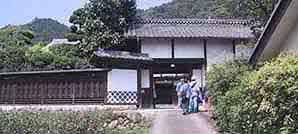 |
A man of medium built, wearing light blue traditional clothes was waiting and greeting us at the gate. He was Yamada Seijiro Sensei, Shihan Yamada's brother, our host. Shihan took us for a brief tour of the immediate area around the main house, first to the tombs of the late Rev. Yamada Tansetu and his wife. |
| Beside them were a few 1000 year-old graves, belonging to their ancestors. We then went passed what appeared like a vegetable garden and the children's quarters. Next we saw a number of 500 year-old graves and finally to the 1000 year-old family shrine where Shihan Yamada rang a bell atop the entrance to the shrine. Each of us were busy taking turns with our cameras for a group photo in front of the shrine not realizing that Shihan was already some distance ahead of us. Soon we could hear him calling us to hurry up. |
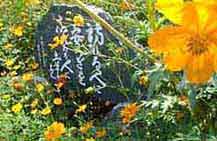
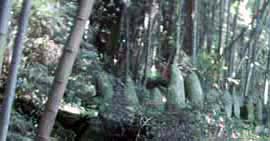

| Back at the main house, we were brought straight to the upper level into a big hall. Along the way we were introduced to Seijiro Sensei's wife and daughter. It was a beautiful double story traditional house. I have always wondered how those fragile looking rice paper walls can withstand the natural elements. So I couldn't resist but touching them. (Yeah - they were paper alright.). There were a lot of empty spaces everywhere. No clutter. If you love the feeling of being in the dojo you would love to spend time in such a house. Very peaceful and relaxing. In the hall upstairs, two long tables with light refreshment has been prepared and waiting for us. Seated on light floor cushions, we could see swords and other weapons laid out on the floor across the hall. Some part of the walls were decorated with Japanese art created by a famous calligrapher during the Meiji period. |
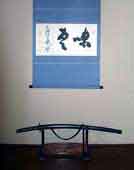
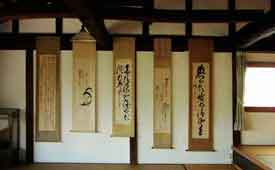
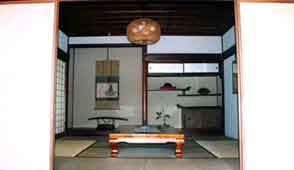
| After tea came the sword appreciation ceremony. I first thought that we were just going to have a "see-no-touch" session. Seijiro Sensei proceeded to show us how to lift, observe and place the weapons back on the display cushion. We were to be in seiza, be gentle about handling the weapons, no swinging. And so we all had the chance to hold in our hands real Japanese instruments of battle dating back to the 13th century! There were five weapons on display. The Tachi sword used on horseback, the Tanto dagger -like blade, the infamous Katana, the Yari spear and the Naginata halberd, a weapon used by lady warriors. I kept my attention to the Tachi and the Katana. You know, after watching "The Last Samurai" recently and all those other Samurai movies, to be able to hold a genuine Katana in your hands was really cool. The Tachi was longer and it weigh lighter than I imagined. I noticed one or two chips along the back of the sword while the cutting edge looked untouched and razor-sharped. Later outside the house, I was told that these swords had been used in battle and there is a story behind those chips along the back. The Samurai makes minimal moves to eliminate his opponent using the sword. In any instance where both warrior's sword were to collide, they would both turn their sword and let only the backs hit each other. Such was their discipline, even in the face of death. The cutting edge is only used to cut the human body. That is why the cutting edge looked untouched and there were chips only along the back. |  |
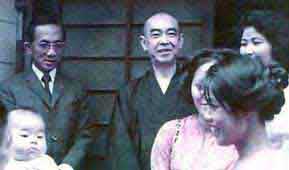 |
While having tea and some sweets, we were told the history of this place, of the Samurai, particularly of the Japanese sword. Shihan Yamada was saying that most (if not all) of the Japanese swords outside Japan were just copies of the original. For generations, Shihan's family has been entrusted to preserve the swords of Shoguns, Emperors and the Nobles. Japanese sword preservation is an art in itself. In the hands of a master craftsman, a sword will remain perfect and shining with minimal maintenance for many many years. Even your perspiration can cause rust to these precious blades! That is how delicate it can be. You can find interesting reading about Japanese swords at Ken and Aikido. Important stuff to know for Aikido practitioners. |
|
On the page you will see a few photographs showing parts of the hall that we had visited. Although everybody was given a chance to marvel at these precious works of art, I found the whole event to be too brief. There was so much beauty to admire, so much of Japan's rich heritage to be discovered and so much of its mystery to be unravelled. As I am practicing my Aikido back home, I continue to marvel at the beauty of this art. I am trying to understand more about its origins and maybe one day, unravell the mystery that The Founder wanted to share with us. | |

| 3 hours ago we were in Tokyo surrounded by skyscrapers and its wide avenues. | |||
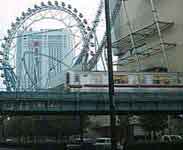 |
 |
 |
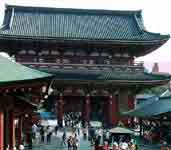 |
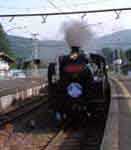 |
 |
"We are getting further away from Tokyo" I thought. Flat urban landscape is slowly being replaced by rolling hills. Chichibu is a mountainous area in the Saitama Prefecture north of Tokyo. Now what we expect to be buildings we now see hills in its place, roads had turned into flowing rivers. Another amazing sight is the Chichibu mountains with its dense conifer forest surrounding Oku-Chichibu. You can see the large Arakawa river here, one of the rivers that pours into Tokyo Bay. Another amazing sight is |
|
the Oku-Chichibu mountains with its dense conifer forest surrounding Chichibu. "Our family had been in Chichibu over a thousand years"said Shihan Yamada. A thousand years? That is a very long time I said. Shihan Yamada's family came from a long line of Japanese warriors. Shihan's father, the late Reverend Yamada Tansetu (1912-1974) was Zen priest, a Katana or Japanese sword scholar and master craftsman. He dedicated his life to perfect the art of preserving Katana. Reverend Yamada established the "Chuo Token Kai" a society dedicated to the study of Japanese swords to ensure Katana are preserved for future generations. After Rev. Yamada's death, Yamada Seijiro Sensei, Shihan's younger brother, succeeded him to lead "Chuo Token Kai". It is Seijiro Sensei and his family that we come to visit in Chichibu |
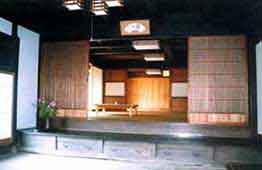 |
today. After a short walk from the Nagatoro station in Chichibu, we soon arrive at Shihan's ancestral home and now home to his brother Yamada Seijiro Sensei. "This house is new" shihan said in jest. "Only about 130 years old as the previous one was destroyed." I naturally thought it must had been destroyed by the forces of nature. Japan has its fair | 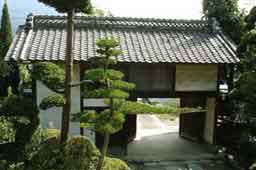 |
| share of natural catastrophes from earthquakes, typhoons to floods and tsunamis. Before I made my own deduction, I remembered 130 years ago Japan is not the peaceful country you see now. It was feudal Japan, the period before the Meiji restoration and birth of modern Japan. Meiji restoration restored the ruling power back to the Emperor rule and eradication of the Shogunate. The Japan that we see today had grown out of the reforms enacted in the Meiji period. Few things strongly symbolize the Shogun than that of the Katana. Katana has often being referred to as the mark of the Samurai. Today I will have a chance to see the Katana up close. A chance to glimpse at the weapon of choice by |
 |
the Bushi and a piece of Japanese Samurai history. As we walked towards the house, Shihan directed us to the rear of his house. We were explained that he has to perform a traditional ritual before entering the house. Being the eldest in the family Shihan Yamada has to announce his return by ringing a bell at the family shrine behind the house. Curiosity got the best of our group and all of us ended following Shihan to witness this old ritual. The shrine is located a short distance away in a bamboo forest just behind Shihan's ancestral home. A small wooden structure, the shrine welcomes visitors with a red arch at its entrance. The bell is placed just in front of the shrine door. Shihan pulled the long rope attched to the bell three times. The sound of the bell filled the air. Somehow all of us feel we are welcomed in Chichibu We feel | 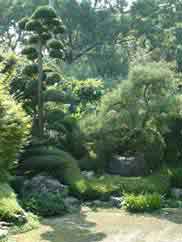 |
| that we are back home. At the house we were welcomed by Seijiro Sensei, his wife and daughter. It was a quiet affair. I did not know what to do as it seemed very formal. The first glimpse I had of the house was magnificent. The house is a wooden structure built in traditional Japanese style. It gives a great sense of space with minimalist simplicity and yet give a stately atmosphere. I liked it immediately. Mrs. Nori Yamada served us Wagashi and tea to welcome us. "This is the best Japanese confectioneryI tasted" I | 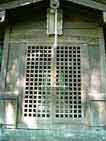 |
 |
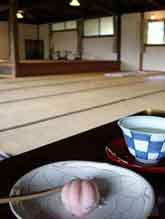 |
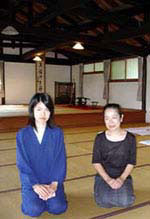 |
quietly told her. It really is, the texture is just so fine. I never could get something like this from the super-market I thought. One can appreciate the amount of refinement that has been put into these cakes. As our group were quietly munching on our rice cakes, all eyes looked at 5 swords laid across the room. As soon as we finished eating and Seijiro Sensei invited us to see the swords up close. Seeing our eagerness he gave us an short explanation on the different types of swords in front of us. On closer inspection the swords are not the same after all. There are of different lengths and shape. The longest of the five, the Tachi sword is used while on horseback while the shortest the dagger or Tanto. The others in the collection are the Katana, Yari (spear) and Naginata. I was explained that the Naginata |
| is a weapon used by women in its time. Fascinating. Its true that the female of the species is deadlier than the male. One thing that amazed me that these swords are over 700 years old. One can't see even any trace of oxidization on any of them. "What oil do you use to maintain them?" I asked Seijiro Sensei. "No oil" he said in disapproval. I hope I did not say anything wrong. It suits me right to draw comparisons with my Parang back home. I usually apply some oil to avoid any rust forming. Seijiro Sensei explained that 8 types of stones and water are used in maintaining and sharpening these weapons. "Only water and stones? That must take you a very long time to even sharp one sword" I asked. 10 days is the average amount of time to sharpen one sword. "It feels lighter than I thought" I heard my friend Fuad saying.. Holding a sword who is over 7 centuries old sword would make anyone think. A sword that has seen the beginning of the | |
| Ottoman Empire, Black Death and the end of Mongol Yuan Dynasty in China. The sword was forged before the Renaissance, Spanish Inquisition and Copernicus's heliocentric hypothesis. Holding so much history in one's hands is not only physical but maybe a spiritual experience as well. In any measure it is a memorable event. When it came to my turn, the Katana does feel lighter than I imagined. The countless stories and history behind these swords had made it looked much heavier than it is. Almost larger than life. The Katana is a remarkable accomplishment. Katana are surrounded by a lot of myths and legends. Its been said that its born from the earth, given life by the fire and has its own spirit. An elegant weapon, the Katana is no decoration or a mantle piece. Make no mistake it is a weapon. So years Samurai used them to |  |
| protect Japan from foreign invasion and the numerous civil wars. Now they are relics, Japan 's national treasures, that serve as a reminder of a life that many long forgotten. The life of noble warriors who gave fought to protect and often gave their lives for Japan. We finally came close to the end of our journey. Having fulfilled my wish to hold the Katana, I come to appreciate them more now. My admiration goes to the Yamada family for their dedication to preserve these treasures. Without them few of these treasures would had been preserved to this day. | |
| Home | Update | Aikikai | The Chairman | The Shihan | 40th | Interview | Promotions | Dojos | Ken | Magazine |